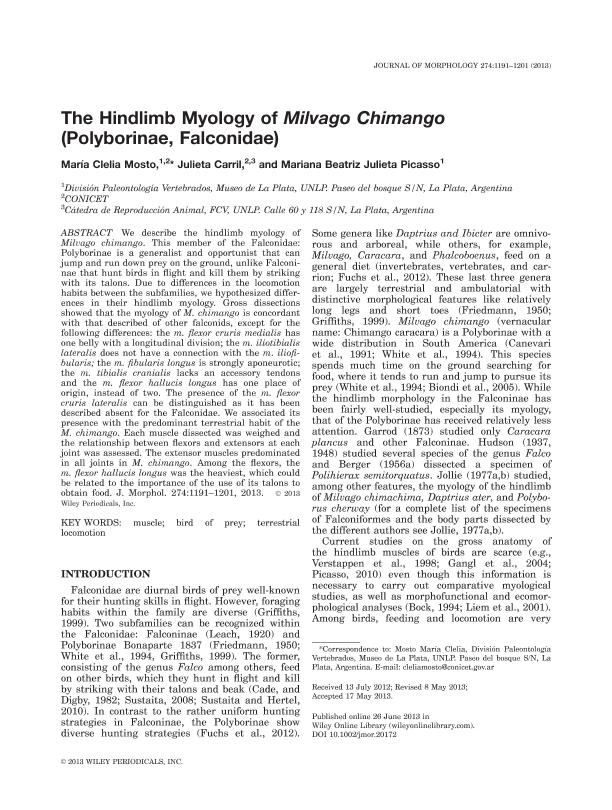Artículo
The hindlimb myology of Milvago chimango (Polyborinae, Falconidae)
Fecha de publicación:
06/2013
Editorial:
Wiley
Revista:
Journal of Morphology
e-ISSN:
1097-4687
Idioma:
Inglés
Tipo de recurso:
Artículo publicado
Clasificación temática:
Resumen
We describe the hindlimb myology of Milvago chimango. This member of the Falconidae: Polyborinae is a generalist and opportunist that can jump and run down prey on the ground, unlike Falconinae that hunt birds in flight and kill them by striking with its talons. Due to differences in the locomotion habits between the subfamilies, we hypothesized differences in their hindlimb myology. Gross dissections showed that the myology of M. chimango is concordant with that described of other falconids, except for the following differences: the m. flexor cruris medialis has one belly with a longitudinal division; the m. iliotibialis lateralis does not have a connection with the m. iliofibularis; the m. fibularis longus is strongly aponeurotic; the m. tibialis cranialis lacks an accessory tendons and the m. flexor hallucis longus has one place of origin, instead of two. The presence of the m. flexor cruris lateralis can be distinguished as it has been described absent for the Falconidae. We associated its presence with the predominant terrestrial habit of the M. chimango. Each muscle dissected was weighed and the relationship between flexors and extensors at each joint was assessed. The extensor muscles predominated in all joints in M. chimango. Among the flexors, the m. flexor hallucis longus was the heaviest, which could be related to the importance of the use of its talons to obtain food.
Palabras clave:
Muscle
,
Bird of Prey
,
Terrestrial Locomotion
Archivos asociados
Licencia
Identificadores
Colecciones
Articulos(CCT - LA PLATA)
Articulos de CTRO.CIENTIFICO TECNOL.CONICET - LA PLATA
Articulos de CTRO.CIENTIFICO TECNOL.CONICET - LA PLATA
Citación
Mosto, María Clelia; Carril, Julieta; Picasso, Mariana Beatriz Julieta; The hindlimb myology of Milvago chimango (Polyborinae, Falconidae); Wiley; Journal of Morphology; 274; 10; 6-2013; 1191-1201
Compartir
Altmétricas




